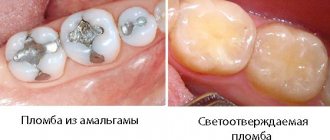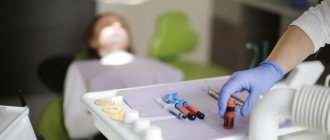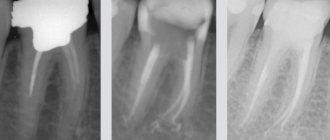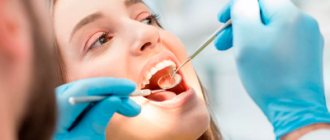Every day, the dentists of our clinic answer questions from their patients and people they consult on the Internet. Often, questions take the form of a complaint about other dentists and most often complain that the tooth hurts after treatment. Indeed, there are objective reasons why a tooth hurts after filling. We will try to help you figure out what could be the cause of the pain and what to do if you find yourself in such a situation.
The cause of tooth pain after treatment depends on the manipulations performed on the tooth. We have divided the large topic of pain after dental treatment into the following subtopics:
1. A tooth hurts after filling, that is, after caries treatment (this article);
2. Tooth hurts after nerve removal and canal cleaning;
3. The tooth under the crown hurts.
This article will discuss pain after caries treatment.
Tooth hurts after filling
If your tooth hurts after a filling for just a few days, then don’t panic! Provided that the pain is not severe, does not arise on its own, but from external factors (during meals, as a reaction to hot/cold), such pain can last up to two weeks. This depends on the individual tissue’s ability to regenerate after the intervention.
The most common reasons that are responsible for toothache after filling:
- Traumatic pain (overheating of the tooth): When preparing a tooth for filling, there is a chance that the tooth's pulp may experience a sudden shock, and this may be the reason why the tooth hurts after filling. If such toothache persists, then, most likely, you will have to treat the root canals.
- Referred pain: The nerves of nearby teeth may carry signals from the nerves of the filled tooth. That is, teeth that were not involved in the treatment process may also hurt.
Misdiagnosis: If there is no correct diagnosis, then there is no correct treatment. This most often happens when the doctor neglects radiography. But there are also borderline cases when the doctor, trying to preserve your tooth as much as possible, uses the least invasive (traumatic) treatment. Sometimes it is worth it, but the result of treatment is not guaranteed (the patient is usually warned about this).
Each person is unique, and the body's response to treatment is always individual. Pain is a normal reaction to external intervention, although we try to minimize it.
How to identify caries
Experts easily distinguish dental caries from other dental diseases. They have many basic and additional diagnostic methods at their disposal. The patient can use some of them independently.
How to determine the intensity of caries
The intensity of caries is the indicator of the ratio of carious, filled and extracted teeth in a patient (CPI index). Possession of this information allows the doctor to judge the quality of the dental care provided, the scope of the upcoming treatment, and the need for orthopedic intervention. The KPU index is calculated for 28 teeth (wisdom teeth are not taken into account) by adding three indicators. The result obtained is checked against the WHO table, taking into account the age of the patient.
How to determine the degree of caries
The disease is classified depending on the degree of its manifestation:
- the first stage (carious stain) - a change in the color of the tooth enamel;
- the second stage (superficial caries) is accompanied by demineralization of the enamel and the appearance of a reaction to cold/hot;
- third stage - dentin is affected, pain intensifies, damage to the tooth is visible externally;
- fourth stage - the peripulpar dentinal area is damaged, which, if left untreated, leads to periodontitis.
How to identify caries by touch
You can sometimes independently understand that a tooth is affected by caries using palpation. If you feel sharp irregularities on the tooth enamel and at the same time food debris periodically gets stuck in them, it means that there is a carious lesion. To identify caries on the lateral, contact surface of dental units, a silk thread is used. Sharp edges of enamel resulting from carious destruction can damage or tear it.
How to identify caries if it is not visible
Often the disease affects the inner layers of the tooth without appearing on its surface. In this case, they use the most informative, accurate method - radiography. It allows you to identify caries without obvious symptoms. Carious cavities in dentin appear on photographs as light spots.
How to determine the depth of caries
Simple ways to determine the depth of a carious lesion include the use of a dental probe. This tool also helps to determine the degree of tooth sensitivity and existing defects. To identify the problem area on the back side of the tooth, a dental mirror is additionally used.
How to identify interdental caries
It is almost impossible to cope with this task on your own. Only a specialist using the diagnostic methods listed above can detect this type of disease in 90% of cases. In addition to radiography, flossing, and probing, it is possible to use a diagnostic agent that works by emitting light waves. They are reflected from the teeth and returned to the device, after which an instant analysis of the data obtained is performed. The presence of carious cavities is confirmed by the receipt of a characteristic signal.
Treatment of caries should not be shelved, as it is a progressive disease. At the Stoma Lux dental clinic, you will be provided with professional assistance for the slightest pain. We use modern equipment and advanced methods of diagnosis and treatment of caries, reducing the risk of complications and pain to zero.
If your tooth hurts when you bite
Most often, it is not possible to catch caries in the stain stage, when it has affected only the top layer of dentin. Because once caries appears, it develops rapidly, quickly penetrating into the dentin of the tooth. And the deeper the caries penetrates into the dentin, the more serious intervention is required during treatment.
If a tooth hurts when biting after a filling, this may be a short-term reaction to the deep preparation. In this case, the pain should go away within two weeks.
In the image of the tooth, you can see that the dentin is directly adjacent to the pulp. The pulp is the very place where pain originates, even with the slightest impact. Therefore, pain when biting can occur when the filling is not polished sufficiently. In this case, when you bite, with another tooth you put pressure on the filling that is too high in the bite, and the filling, in turn, physically affects the pulp, and then the tooth hurts under the filling.
Many people think that they can wait a few days and the filling will wear itself out. This is not true; a filling that is too high in bite size injures the surrounding tooth tissue, which may lead to the need to re-treat the tooth, and possibly even to removal. And why endure this unexpected sharp pain if you can ask your dentist to further polish the filling? This is an absolutely painless and quick procedure.
Also, pain in the tooth after filling when biting may indicate inflammation of the surrounding tooth tissue. If you do not feel the filling, but the pain becomes more frequent and stronger, then you need to contact your doctor to determine the exact cause.
If the pain bothers you for more than two weeks or becomes unbearable, you should immediately contact your doctor.
The tooth may need to be refilled using a different material. The dentist may decide to place medication and a temporary filling.
Pain when pressing as a sign of periodontitis
When a tooth hurts severely when pressed, this may be a sign of periodontal pathology. Periodontitis is an inflammation of the periodontal tissues that are located between the jaw bone and tooth roots.
This disease usually develops against the background of chronic pulpitis or deep caries. In addition to painful sensations, periodontitis is usually accompanied by suppuration, swelling and redness of the gums, increased body temperature and a feeling of mobility of the diseased tooth.
If you suspect periodontitis, contact your dentist as soon as possible. The disease cannot be neglected, otherwise a flux, abscess or other dangerous complication will occur.
PS
In this article, we deliberately do not touch upon mistakes made by dentists that may cause pain. God forbid that a seed of doubt should be planted in you. It is very important to trust your doctor or better look for another! Any doctor will say that the most difficult patient is the patient who does not believe in his recovery. But if you have doubts about the doctor’s competence, then the best decision is to go to another for a second opinion. Take pictures before and immediately after treatment, and keep these pictures for yourself. This will help prove you are right if something goes wrong. And trust your doctor!
The situation where pain may occur is quite predictable. In such cases, the dentist always warns the patient about possible pain. And if the pain goes away after a week or two, then there is nothing to worry about.
Pain after pulpitis treatment
When treating pulpitis, the nerve is removed and the canals are cleaned. This is a complex procedure during which special instruments are inserted into the root canals, which can injure tissue near the apex of the root. When treating canals, powerful antiseptics are used, which sometimes irritate nearby tissues. Therefore, after the end of anesthesia, patients almost always feel pain of varying intensity.
When the canal filling procedure is carried out correctly, the pain goes away within 1-7 days, gradually subsiding until it disappears completely.
How to maintain your treatment guarantee
To maintain the guarantee, the patient must strictly follow all recommendations: do not overload the tooth, do not use it for other purposes (for example, opening beer bottles, biting off threads), and also regularly see the doctor in accordance with the individual schedule of medical examinations, approximately once every six months. Unfortunately, many patients forget about this, and it is the last point that is the key to maintaining the guarantee for treatment.
You need to visit a doctor 1-2 times a year. During a preventive examination, the dentist will be able to make sure that the filling is in good condition, and that secondary caries does not develop again under it.
How to relieve pain at home
When discomfort bothers you after cleaning the root canals and installing permanent or temporary fillings, the discomfort can be relieved at home. Universal methods include:
- Warm rinses with a solution of soda or salt, or a combination of these ingredients.
- Decoctions of medicinal herbs (sage, oregano, chamomile, calendula, mint) help well. Their effect is calming. Procedures must be carried out at least 4-5 times a day.
- Apply a small piece of propolis to the sore spot, and rinse your mouth with the tincture of this bee product, adding half a teaspoon to a glass of water.
- Plantain leaves or roots are applied to the diseased unit.
- Lavender, St. John's wort, and clove oils are often used. They moisten a gauze swab and apply it to the sore spot.
- Drug therapy. We are talking about painkillers. Temporarily relieves pain by taking Nimesulide, Ketanov, Tempalgin, Naiza, Baralgin according to the instructions.
To prevent increased pain in the first two to three days:
- You should avoid cold, hot, sour, sweet foods, and eat only warm foods that do not irritate the tissue, especially if the incisors and molars are overly sensitive;
- Avoid hypothermia;
- Remove from the menu solid foods that need to be bitten into pieces;
- Do not load on the causal unit;
- Chew on the opposite side of the jaw;
- Regularly and thoroughly brush your teeth and maintain oral hygiene;
Remember that when taking medications that dull pain, do not increase the dosage yourself. After all, this way you can muffle unpleasant symptoms and disguise the true aspects of the pathology.
When is there a reason to worry?
Sometimes doctors recommend that their patients take painkillers after treatment, as they objectively assess the complexity and assume temporary side effects. But symptom relief does not take longer than 3-4 days even after tooth extraction. You must understand that pain is not an enemy at all, but a benefit that signals a problem. And if it appears on an ongoing basis for a week or more, this is a good reason to visit a specialist.
Pay close attention to any accompanying symptoms:
- Fever or slight but constant increase in temperature;
- Bleeding gums around the treated tooth;
- Acute attacks that occur at night;
- A significant increase in sensitivity, encouraging you to completely abandon potential irritants in the form of ice cream or hot tea;
- Numbness of the soft tissues of the jaw at the site of the procedures;
- Darkening or blueness of the gums;
- General malaise and weakness without objective reasons.
Constant aching pain with periodic exacerbations can be associated with overdrying or underdrying of the formed cavity before filling. Both mistakes by the doctor are fraught with complications. When overdrying, persistent irritation of nerve endings can occur, leading to death. If it is not dried enough, the adhesive (sticky material) cannot be absorbed into the dentin, and when the filling shrinks, it comes off from the bottom of the cavity, creating a discharged space here like a vacuum. This also irritates the nerve endings (in professional language the phenomenon is called “debonding”).
In both cases, there is no point in enduring pain for more than a week. Perhaps after 7 days it will really stop bothering you, and the reason for going to the dentist will disappear by itself. But if a week after treatment has passed and the symptom persists, you should immediately visit a doctor.
How to relieve toothache yourself?
- If pain occurs, the right solution would be to take special painkillers. Dentists advise their patients Nurofen, Ketanov, Dexalgin, Baralgin. You can also take regular analgin in tablets. Specialists at Dr. Granov's clinic strongly recommend that you stop taking aspirin and medications containing high concentrations of acetylsalicylic acid. The analgesic effect from them is small, but in high dosages the substance provokes complications, sometimes very dangerous for general health.
- Temporarily stop chewing food on the affected side. Perhaps the symptom is associated specifically with biting - that is, mechanical irritation.
- Under no circumstances use “grandmother’s methods” in the form of heating, lotions or compresses. The procedure can significantly aggravate the current situation and even obviously complicate the process of subsequent treatment, if necessary.
- Antibiotics should not be taken without a doctor's prescription. The selection of antibacterial drugs is a responsible step in which the doctor carefully weighs the benefits and risks. Unauthorized use of antibiotics can lead to unpredictable consequences.
- You can purchase a natural product at the pharmacy - dental drops. It contains plant extracts of valerian, mint and camphor. Soak a tight cotton swab in the solution and apply it to the sore tooth. Change the tampon every 10 minutes until pain subsides.
- You can help yourself by rinsing with decoctions of soothing herbs: mint, lemon balm, chamomile.











